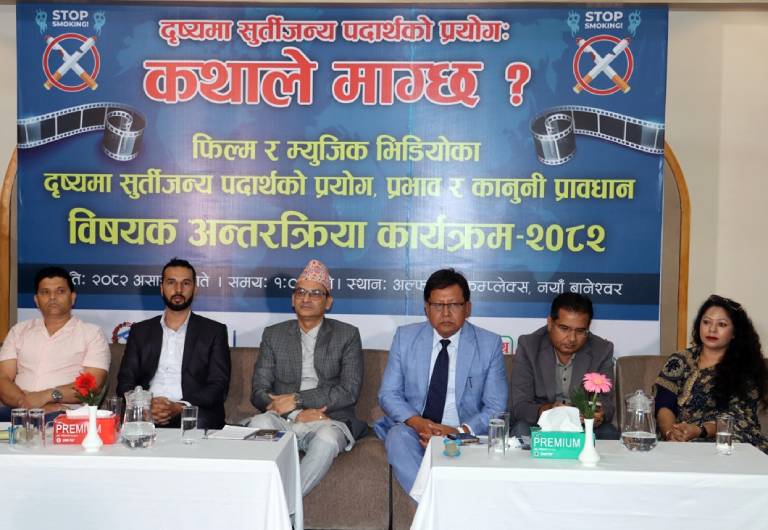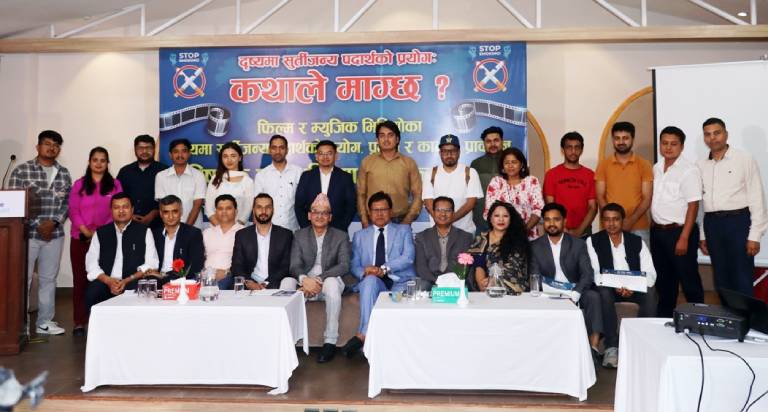
Kathmandu – Stakeholders have agreed on the need to explore alternatives to scenes depicting the use of tobacco products in films and music videos. During an interaction program held in the capital on Monday, emphasis was placed on avoiding such scenes unless absolutely necessary.
Speaking at the event titled “Use of Tobacco in Visual Media: Does the Story Demand It?” — organized by Swasthya Khabar Foundation with support from the Ministry of Health and Population, Inland Revenue Office, and Film Development Board — various stakeholders expressed their concerns. These included Dr. Vikas Devkota, Secretary of the Ministry of Health and Population; Dinesh DC, Chairperson of the Film Development Board; Janakdeep Parajuli, Chair of the Directors’ Society; and actor Shankar BC.

Dr. Devkota highlighted the direct influence of the arts and called for creative alternatives to scenes involving tobacco use. “Even now, we wonder if we look like Rajesh Hamal when we wear a hat. Women may also have their own perceptions. That’s the impact of cinema — its scenes influence everyday lives,” he said.
Rather than simply advising creators on content, he urged them to lead in setting global standards by creating compelling scenes without relying on tobacco. “Since art connects with people across all demographics, you can portray powerful characters without cigarettes or tobacco,” he added.
Film Development Board Chair Dinesh DC suggested that creative approaches could help reduce the portrayal of tobacco in media. He partially agreed with the argument that children can learn to use tobacco by watching films. “I recall when I was a student, I was tempted to imitate actor Rajinikanth’s stylish cigarette flipping after seeing it on screen,” he said.
He warned that cinematic content not only promotes tobacco use but also teaches methods of consumption, calling on the creative industry to remain vigilant.
Director Janakdeep Parajuli expressed concern that films might become impossible to make if filmmakers had to comply with demands from sectors like police, health, and civil services. However, he acknowledged the need for careful thought before including such scenes. “As filmmakers, we are aware of the impact. Yet we continue to use these depictions — that must be addressed,” he said, noting that such scenes are generally included only when the story demands it.
Similarly, Anand Chand, President of Action Nepal, said the arts mirror society and thus require heightened awareness. Citing research, he noted that many people admit to learning tobacco use from scenes in films. “Given how such scenes are presented in films and music videos today, it almost appears as though tobacco companies are indirectly supporting them. Creators must become more conscious,” he said.
Former President of the Music Video Artists Association and artist Shankar BC said there has been a reduction in such scenes compared to the past. He attributed this to growing awareness among artists, even though some scenes are still created by imitation.
Gopikrishna Regmi, Undersecretary at the Ministry of Health, said the idea for the program emerged after observing the frequent depiction of tobacco use in films. The initiative aims to raise awareness among artists by informing them about relevant laws and public health concerns.
At the event, Dr. Bhakta KC, Information Officer at the Ministry of Health, discussed the health hazards posed by tobacco use and emphasized the need for the arts to contribute positively to public health.
Participants in the program included professionals from the film and music video industries, officials from the Ministry of Health, and journalists covering health and entertainment.







